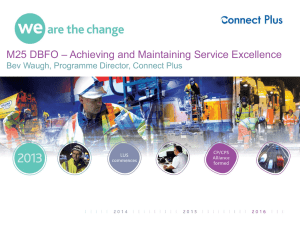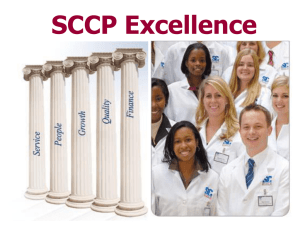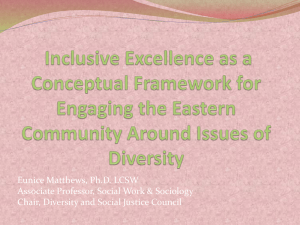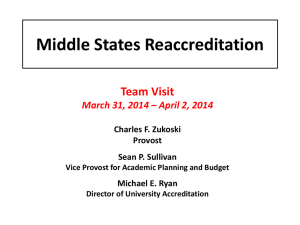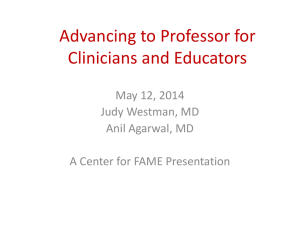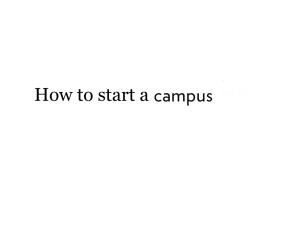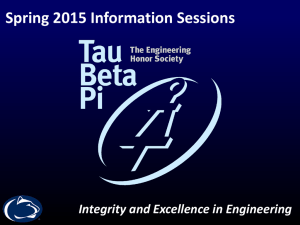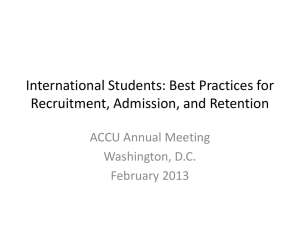Acclamation 2014 - Misericordia University
advertisement
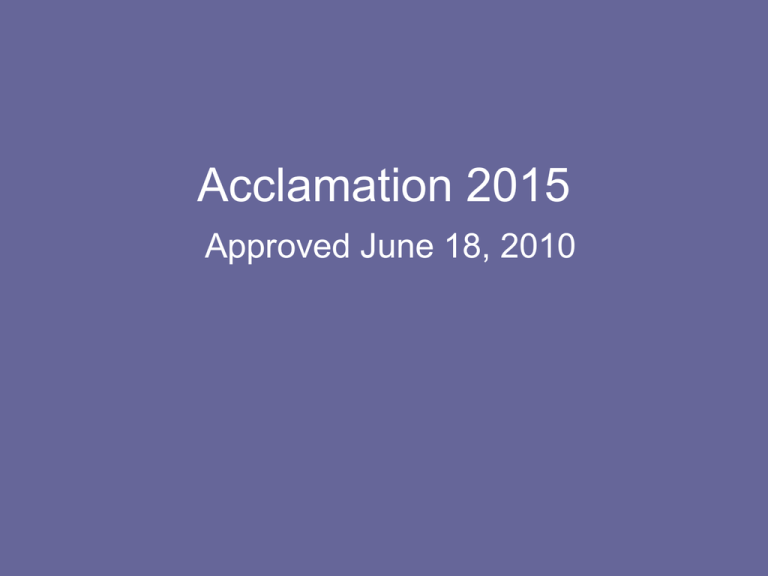
Acclamation 2015 Approved June 18, 2010 Preamble Misericordia University’s new strategic plan is a roadmap designed to transform the University. Acclamation 2015 is the next step in a process that has generated significant success for the institution and its graduates. As a result of the accomplishments of the last two strategic plans, Misericordia has moved from period of subsistence to sustainability. We now intend to take a bold step and evolve from a position of sustainability to one of acclamation. Over the next five years Misericordia will undertake new initiatives and audacious thinking to brand itself as regionally acclaimed and nationally recognized for our distinctive approach to teaching and learning. The prominent initiatives in this plan will not be easily achieved. However, with optimal use of current and future resources, attainment of an aggressive enrollment target of 1812, excellent communication and management, and adherence to our brand, the vision of Misericordia University delineated herein is well within reach if the entire Misericordia community thinks progressively and acts aggressively in striving to reach the goals. A Vision of Acclamation Based firmly upon its Catholic identity and Mercy traditions, Misericordia University is a premier small, liberal arts based Catholic university in the northeast. Misericordia’s ability to effectively combine outstanding academics, superb career preparation and passion for serving others—our Trinity of Learning—has elevated the University to a position where it is regionally acclaimed and nationally recognized for graduating students who have, indeed, learned to succeed. VISION: ACCLAMATION 2015 Based firmly upon its Catholic identity and Mercy traditions, Misericordia University is a premier small, liberal arts based Catholic university in the northeast. Misericordia’s ability to effectively combine outstanding academics, superb career preparation and passion for serving others—our Trinity of Learning—has elevated the University to a position where it is regionally acclaimed and nationally recognized for graduating students who have, indeed, learned to succeed. MISSION GOAL Misericordia University is a stellar Catholic and Mercy institution, nationally recognized for our seamless integration of mission and academic excellence. 21ST CENTURY CURRICULUM GOAL Misericordia University’s educational programs, including the liberal arts based core curriculum, major programs, and the cocurriculum, are academically rigorous, distinctive for their interconnectedness, and recognized by prospective students, our peer institutions, and employers for the University’s integrated and holistic approach to teaching and learning. INCLUSIVE EXCELLENCE GOAL Misericordia University is transformative for students, faculty, staff, and our extended community through our efforts to engage and exemplify diversity and to create an environment that is defined by inclusive excellence. FACULTY EXCELLENCE IN TEACHING & SCHOLARSHIP GOAL Faculty excellence in teaching, research and other scholarly endeavors insures academic excellence permeates Misericordia University. The University is known for personal attention, robust student-faculty interaction and facultydriven quality in all majors, which allows us to attract, hire and retain talented faculty. COMMUNICATION & MANAGEMENT GOAL Misericordia University’s growth and progress is facilitated by effective, timely, and clear communication and management systems. Mutual trust permeates our organizational culture. While our goal is efficient management, we are guided by our charisms and emphasize civility and mutual respect in our communication and management styles. RESOURCES GOAL - Misericordia University is a financially strong and vibrant institution that invests appropriately in its employees, campus, operations and reserves. The beautiful campus is well-maintained and evolving. Employees are appropriately compensated and feel well-treated, respected and supported both individually and operationally. MARKETING GOAL – Through a collaborative effort between faculty, staff, students and the marketing department, Misericordia University is known for academic rigor, excellence among faculty and staff, and students who are not only prepared professionally but who also have a passion for serving others. Mission Goal: Misericordia University is a stellar Catholic and Mercy institution, nationally recognized for our seamless integration of mission and academic excellence. 1.1 Increase service-learning participation for students, faculty and staff 1.2 Develop flagship Mercy orientation and Mercy integration programs for students, faculty and staff 1.3 Develop courses throughout academic and co-curricular programming that authentically and explicitly address mission 1.4 Use, promotion, and dissemination of Mercy Matrix as Catholic highered standard for assessing mission integration 1.5 Attain national recognition for campus-wide mission integration and articulation Manager: Sr. Bernadette Duross 5 Mission Strategies and Indicators STRATEGIES 1.1 Increase service-learning participation for students, faculty and staff 1.2 Develop flagship Mercy orientation and Mercy integration programs for students, faculty and staff 1.3 Develop courses throughout academic and co-curricular programming that authentically and explicitly address mission 1.4 Use, promotion, and dissemination of Mercy Matrix as Catholic higher-ed standard for assessing mission integration 1.5 Attain national recognition for campuswide mission integration and articulation INDICATORS 1.1 Percent participation (student and faculty) in service-learning 1.2 Percent participation in Mercy orientation and integration programming 1.3 Number of courses developed 1.4 Assess institution using Mercy Matrix as appropriate 1.5 National and regional conference presentations and publications related to mission DASHBOARD INDICATORS: Percent participation in service-learning courses; Mercy Matrix assessment score 6 21st Century Curriculum GOAL: Misericordia University’s educational programs, including the liberal arts based core curriculum, major programs, and the co-curriculum, are academically rigorous, distinctive for their interconnectedness and recognized by prospective students, our peer institutions, and employers for the University’s integrated and holistic approach to teaching and learning. 2.1 Create, enhance, and/or accredit new and existing degree programs that attract traditional and non-traditional students and enable them to pursue 21st century careers and/or post-graduate study. New programs must result in a positive contribution margin 2.2 New core curriculum emphasizes an integrated liberal arts and professional preparation learning experience 2.3 New co-curriculum experiences seamlessly connect academic and campus programming, including the expansion of experiential learning and cultural and athletic programming 2.4 Develop a dynamic and responsive culture of assessment that informs planning and program development, guides reallocation of resources where appropriate, and results in continuous improvement 2.5 Develop an intercultural study program that supports global courses, study abroad and experiential learning opportunities 2.6 Implementation of an innovative foreign language program Manager: Mari King, Deans 7 21st Century Curriculum Strategies and Indicators STRATEGIES INDICATORS 2.1 Create, enhance, and/or accredit new and existing degree programs that attract traditional and non-traditional students and enable them to pursue 21st century careers and/or postgraduate study 2.2 New core curriculum emphasizes an integrated liberal arts and professional preparation learning experience 2.3 New co-curriculum experiences seamlessly connect academic and campus programming, including the expansion of experiential learning and cultural and athletic programming 2.4 Develop a dynamic and responsive culture of assessment that informs planning and program development, guides reallocation of resources where appropriate, and results in continuous improvement. 2.5 Develop an intercultural study program that supports global courses, study abroad and experiential learning opportunities 2.6 Implementation of an innovative foreign language program 2.1a Graduate and/or professional school acceptance rates 2.1b Percentage of students with jobs in field of study at graduation 2.1c Professional exam first time pass rates 2.1d Employer survey ratings on student preparedness in career 2.2 NSSE academic challenge and active and collaborative learning ratings 2.3a NSSE enriching educational experiences ratings 2.3b Student participation in academic, cultural and athletic programming 2.4 Percentage of student learning outcomes comprehensively (in majors and core) assessed annually 2.5 Number of students participating in study abroad and/or intercultural experiences 2.6 TBD DASHBOARD INDICATORS: NSSE - LAC, EEE, ACL measures; Post graduation employment and graduate school rates 8 Inclusive Excellence GOAL: Misericordia University is transformative for students, faculty, staff, and our extended community through our efforts to engage and exemplify diversity and to create an environment that is defined by inclusive excellence. 3.1 3.2 3.3 3.4 Initiate and support campus and community-wide diversity initiatives Develop an intercultural office that provides and promotes campus programming focused on diversity and inclusive excellence Develop courses in core and majors that are focused on foreign language acquisition, diversity and global issues Increase institutional diversity demographics by recruiting and retaining a diverse population Manager: Mary Hinton 9 Inclusive Excellence Strategies and Indicators STRATEGIES 3.1 Initiate and support campus and community-wide diversity initiatives 3.2 Develop an intercultural office that provides and promotes campus programming focused on diversity and inclusive excellence 3.3 Develop courses in core and majors that are focused on foreign language acquisition, diversity and global issues 3.4 Increase institutional diversity demographics by recruiting and retaining a diverse population INDICATORS 3.1 Number of diversity programs delivered on campus 3.2a Number of participants in intercultural programs/experiences 3.2b NSSE measures regarding diversity 3.3 Number of courses developed in core and major programs focused on foreign language, diversity and/or global awareness 3.4 Carry over 04-09 demographic measures with increasing numbers DASHBOARD INDICATORS: Demographics; Number of intercultural courses/programs 10 Faculty Excellence in Teaching and Scholarship Goal: Faculty excellence in teaching, research and other scholarly endeavors insures academic excellence permeates Misericordia University. The University is known for personal attention, robust student-faculty interaction and faculty-driven quality in all majors, which allows us to attract, hire and retain talented faculty. 4.1 Maintain appropriate ratio of adjuncts to full-time faculty 4.2 CETL provides pedagogical and professional development assistance and supports research grant acquisition 4.3 Identify, orient, and support adjuncts so that, when utilized, they uphold highquality student-faculty interactions 4.4 Provide and promote opportunities for significant, high-quality student-faculty interaction 4.5 Optimize available resources for research, including faculty research and summer research grants, and support for securing external funding, thereby insuring that resources match faculty needs 4.6 Provide innovative solutions to science facility and other lab needs that are aligned with faculty teaching and research 4.7 MU will remain a leader among its peers in providing class sizes that foster personal attention in major programs and in the core curriculum Manager: Mari King, Deans 11 Faculty Excellence in Teaching and Scholarship Strategies and Indicators STRATEGIES 4.1 Maintain appropriate ratio of adjuncts to fulltime faculty 4.2 CETL provides pedagogical and professional development assistance and supports grant acquisition 4.3 Identify, orient, and support adjuncts so that, when utilized, they uphold high-quality studentfaculty interactions 4.4 Provide and promote opportunities for significant, high-quality student-faculty interaction 4.5 Optimize available resources for research, including faculty research and summer research grants, and support for securing external funding, thereby insuring that resources match faculty needs 4.6 Provide innovative solutions to science facility and other lab needs that are aligned with faculty teaching and research 4.7 MU will remain a leader among its peers in providing class sizes that foster personal attention in major programs and in the core curriculum INDICATORS 4.1 4.2 4.3 4.4 4.5a 4.5b 4.6a 4.6b 4.7 Identify and maintain various adjunct ratios (determined by college and department needs) Number/percentage of faculty participating in professional development via CETL Adjunct evaluation scores related to SFI NSSE Student-Faculty Interaction (SFI) and Level of Academic Challenge (LAC) index ratings Number/percentage of faculty attaining faculty research and summer research grants Percentage of faculty with publications and/or conference presentations (annually) Percentage of science faculty conducting lab research Science facility capital campaign plan and building design approved by 2015 Graduating student survey and faculty satisfaction survey ratings regarding class size DASHBOARD INDICATORS: Faculty Satisfaction Survey; NSSE LAC index ratings; Publication/Presentation percentages 12 Communication and Management Goal: Misericordia University’s growth and progress is facilitated by effective, timely, and clear communication and management systems. Mutual trust permeates our organizational culture. While our goal is efficient management, we are guided by our charisms and emphasize civility and mutual respect in our communication and management styles. 5.1 Roles and responsibilities are clarified and upheld to enable decisions to be made at the appropriate level 5.2 Decision making is done in a timely and transparent manner 5.3 Improve communication between and among faculty, staff and administrators at every level, insuring that University-wide communications are timely and widely shared Manager: Sr. Bernadette and Rebecca Steinberger 13 Communication and Management Strategies and Indicators STRATEGIES 5.1 Roles and responsibilities are clarified and upheld to enable decisions to be made at the appropriate level 5.2 Decision making is done in a timely and transparent manner 5.3 Improve communication between and among faculty, staff and administrators at every level, insuring that University-wide communications are timely and widely shared INDICATORS 5.1 Organizational charts developed, utilized and updated annually 5.2 Utilization of online technology and decision models in announcing areas of responsibility for decision-making, proposed timelines and progress towards final decisions 5.3 Faculty and staff satisfaction survey ratings on communication and management DASHBOARD INDICATORS: Faculty and Staff Satisfaction Survey Ratings; 14 Resources Goal 6: Misericordia University is a financially strong and vibrant institution that invests appropriately in its employees, campus, operations and reserves. The beautiful campus is well-maintained and evolving. Employees are appropriately compensated and feel well-treated, respected and supported both individually and operationally. 6.1 6.2 6.3 6.4 Establish a transparent and timely resource, budgeting, planning and allocation process Provide the appropriate level of support, resources, and compensation to employees Secure funding through revenue generation and expense reallocation to improve Misericordia’s financial position and to address the institution’s priorities Evolve the campus, physically and operationally, into a well-functioning, extended campus that meets the needs of our traditional and non-traditional students, scholarathletes, and employees Manager: John Risboskin 15 Resources Strategies and Indicators STRATEGIES INDICATORS 6.1 Establish a transparent and timely resource, budgeting, planning and allocation process 6.2 Provide the appropriate level of support, resources, and compensation to employees 6.3 Secure funding through revenue generation and expense reallocation to improve Misericordia’s financial position and to address the institution’s priorities 6.4 Evolve the campus, physically and operationally, into a well-functioning, extended campus that meets the needs of our traditional and nontraditional students, scholarathletes, and employees 6.1 Faculty and staff satisfaction with involvement in budget preparation (Faculty Satisfaction Survey Question 23; consider new question in staff survey) 6.2a Faculty satisfaction with the availability of resources for academic needs of faculty (Faculty Satisfaction Survey Question 5k) 6.2b Salary goals to be developed 6.2c Employee satisfaction % 6.3a Viability ratio 6.3b Endowment fair market value 6.3c Dollars allocated to strategic plan activities 6.4a Overall student satisfaction with facilities (new question for the Graduating Student Survey) 6.4b Overall student satisfaction with support and administrative services (new question for Graduating Student Survey) 6.4c Faculty and staff satisfaction with physical facilities (Faculty Satisfaction Survey Quest 17/18; consider new question for staff survey) DASHBOARD INDICATORS: Endowment contribution, Student, faculty and staff satisfaction ratings 16 Marketing Goal 7: Through a collaborative effort between faculty, staff, students and the marketing department, Misericordia University is known for academic rigor, excellence among faculty and staff, and students who are not only prepared professionally but who also have a passion for serving others. 7.1 7.2 7.3 Collaboratively promote, internally and externally, faculty excellence in research and teaching and student accomplishments Develop and implement a marketing strategic plan that emphasizes new and non-traditional programs In concert with communication and management initiatives, coordinate an internal marketing plan designed to shift our campus culture to one that anticipates and explicitly works toward acclamation Manager: Sue Helwig, Deans 17 Marketing Strategies and Indicators STRATEGIES 7.1 Collaboratively promote, internally and externally, faculty excellence in research and teaching and student accomplishments 7.2 Develop and implement a marketing strategic plan that emphasizes new and non-traditional programs 7.3 In concert with communication and management initiatives, coordinate an internal marketing plan designed to shift our campus culture to one that anticipates and explicitly works toward acclamation INDICATORS 7.1 Number of faculty who receive recognition in the press (annually) 7.2 Number of annual marketing strategic plan benchmarks met 7.3 Faculty and staff satisfaction survey responses DASHBOARD INDICATORS: Number of faculty who receive recognition in the press (annually) 18
